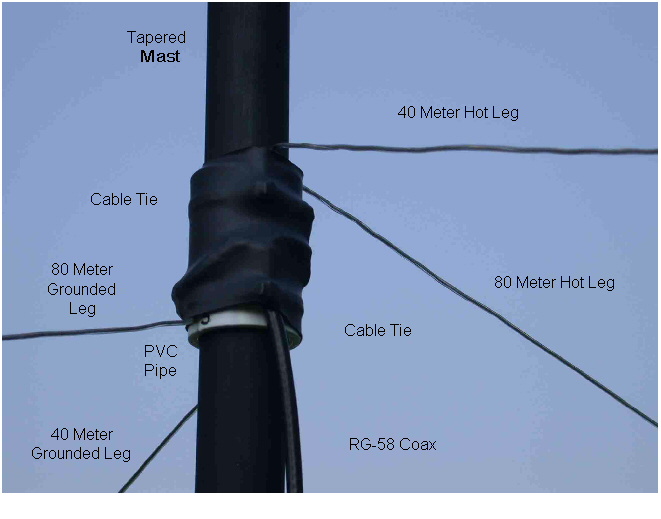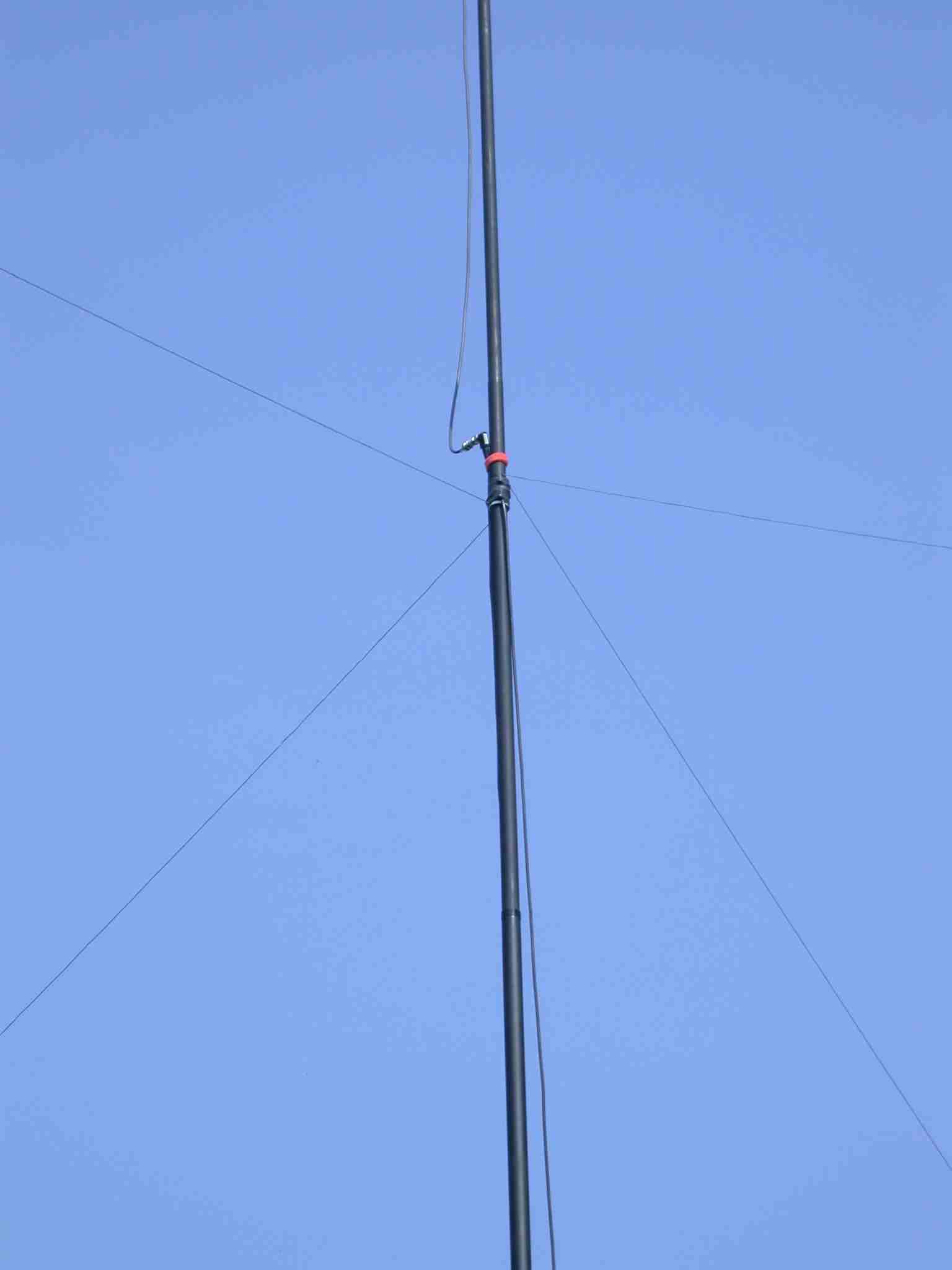

Amateur Radio stations deploying to disasters often need to quickly erect both HF NVIS and VHF antennas to quickly establish local and regional emergency communications. This describes a portable antenna system that can provide both fifty mile range on 2 meters and 300 mile NVIS HF coverage on the 40M and 75M bands. Additional non-NVIS coverage can also be utilized. It can be modified to provide NVIS on 60 meters if that is necessary. It fits in a used computer case and a three pound mast that collapses to a 44inch long tube. Setup time is less than ten minutes.
The US military uses an NVIS HF antenna system consisting of a sixteen foot mast/feed line supporting two inverted Vees tuned to military 6 and 9 MHz frequencies deployed at right angles to one another. By having the 4 antenna legs 90 degrees apart, the elements also serve as guys for the mast and elevated feed point. The problem is that this antenna system is expensive and obviously not optimized for Amateur Radio frequencies. W0IPL experimentally determined better lengths for a similar antenna system for the Amateur 75, 60 and 40 meter amateur bands. This antenna is based on that work.
While some might wish to construct their own mast out of PVC pipe sections, I already had a collapsible 33 foot tapered fiberglass mast sold by DK9SQ www.bright.net/~kanga/kanga/dk9sq/mast.htm It tapers from a 2-1/2 inch diameter at the bottom to a 1/8 inch point at the top. It collapses to a 44 inch long 3 lb package and costs about $100. Similar collapsible masts are also available from Worldradio and MFJ Enterprises.
Since the mast is tapered, a three inch length of 1 inch I.D. PVC pipe slides over it to act as the feed point of the inverted Vees. Based on the taper of the mast, a 1 inch ID PVC pipe section slipped over the top comes to rest about fifteen feet from the bottom of the mast. This is the typical desired center height for 75 and 40 meter inverted vee's operating in NVIS mode.
A 100 foot spool of 22 gauge speaker zip cord from Radio Shack was used for the legs of the inverted vees. A 55.2 foot length was cut for the 75 meter dipole and a 31 foot length was cut for the 40 meter dipole. If you wish, one of the antennas maybe substituted with a 42.3 foot length for 60 meters. You might wish to make the legs a bit longer to allow trimming down to your desired EmComm center frequencies with a SWR meter or antenna analyzer. After cutting to length, the wires were then "unzipped" to become individual wire legs that resist kinking when deploying and stowing. Four inches of insulation was stripped from each of the four wires for connection to the coax. Four inches of the RG-58 coax was stripped and the braid separated from the from the center conductor.
A groove the width and thickness of a cable tie was routed around the outside of the pipe a half-inch from each end using a Dremel motortool. This helps keep the cable ties from slipping off the end of the PVC pipe section. The cable tie in the top groove secures the hot legs of the two dipoles and the bottom one secures the legs that connect to the coax shield. The two dipoles are arranged so that they are deployed ninety degrees to each other when viewed from above.
Electrical tape is used to hold the four legs to the PVC pipe while you permanently secure them in place with the cable ties. The cable ties go over the insulated part of the dipole leg wires with the bare connector towards the middle of the pipe. The bottom cable tie also holds the RG-58 coax in place.
Before tightening the cable ties, the hot leg of each dipole was soldered to the center conductor and the grounded legs were soldered to the shield of the RG-58. The wires were then arranged neatly and the cable ties were secured completely. The assembly was then wrapped tightly with electrical tape to further secure things. I also covered the cylinder with a section of Heat shrink tubing to further tighten things and improve appearance. To reduce RF currents on the coax at the operating position, ferrite beads on the coax, a 1:1 balun, or ten turns of coax in a 4 inch diameter loop may be added.
Simple plastic cafe curtain rings for end insulators and light nylon cord complete the two HF NVIS Inverted Vee's. Mark each leg of one dipole with one color marker and use another color for the other dipole so you can tell the ends apart when deploying. Children's kite cord spools from a dollar store make it easy to store and deploy the legs and support lines.
Since 90 percent of all amateur radio emergency communication involves 2 meter FM, a simple roll-up two meter J Pole antenna made of 300 Ohm ladder line was prepared. Plans for these as well as commercial models are easily found on the internet. A short loop of fishing line with a 1/4 inch loop was attached to the J pole to hold it near the top of the tapered mast at the thirty three foot level. Since the mast is fiberglass, the antenna can rest against it with no significant electrical concerns. The thirty foot elevation greatly extends the range of your two meter radio. RG-8X is recommended for the VHF feed line as the losses of RG-58 are much greater at these frequencies.
Alternatively, DK9SQ also makes a nice collapsible log periodic antenna covering the two meter and 440 bands that can be mounted above the NVIS array instead of the J Pole. This is useful for increasing gain a specific direction or adding a multiband VHF capability.
A space about a hundred feet in diameter is needed for deployment. If possible, locate a vertical object such as signpost to strap the mast to near the center of the desired location. This is not entirely necessary as the antenna legs can serve as guys for the lightweight mast, but it eases extension of the mast and makes it more secure in winds. A four foot length of angle iron driven a foot or so into the ground or a tripod can also be used as a lashing point or a length of rebar can be driven into the ground and the hollow mast (without its bottom plug) placed over it. A four foot length of 1-1/2 ID PVC pipe cut at an angle could be used similarly as an anchor screwed into sand in desert or beachfront deployment.
Stepwise process:

